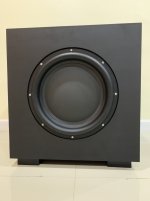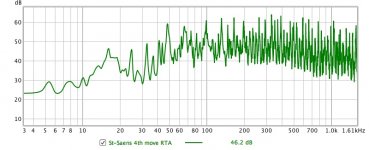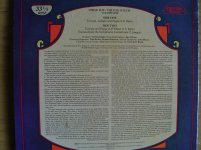LOL Did you carefully read whole sentence with understanding in the context or should I return back to school to learn English?
Straight to an ad hominem attack. Seems like a poor way to seek understanding.
You said it can't be calculated "for any practical case". I disagree. Practical people accept that calculations can be close enough to be useful. I have found REW calculations to be very informative and results have been close enough to help decide where to place heavy boxes in a room without actually moving them to 100 different places to see how it sounds. I think there are many other users of REW that have found the same to be true. Your mileage may vary.
Last edited:
I wouldn't call you dumb. Room gain and it's affect are complicated, room dimensions shape and items in the room plus listening position all affect it. Sealed speakers have a shallow roll of were vented is steep. Sealed speakers have a better transient response which means the speaker cone stops sooner after the signal is gone. Vent speakers keep moving after the signal is gone due to stored energy. This is why sealed are often called faster which is not the best description. So to answer your question a sealed sub of 30hz lower limits still has output below that and room gain reinforces it.
I wouldn't call you dumb. Room gain and it's affect are complicated, room dimensions shape and items in the room plus listening position all affect it. .
I recommend you go look at the REW software.
REW software includes room dimensions and speaker and listener location and calculates response based on all of that. If you had looked at it, you wouldn't have bothered to post your comment. It's free, don't be scared, you can go look at it.
Guess you are right, I was still thinking old school Klipsch logic
( how big does a speaker have to be to reproduce a 16' organ pipe) but it's still actually been quite a while since I've listened to Bach's Tocatta & Fugue anyway. Room Gain - how big does a room have to be to provide room gain at 30 Hz ...is it one wavelength or 1/2 a wavelength - I'm just a dumb musician...
The 16' ranks are not usually a big problem but the 32' ranks are another kettle of sashimi.
Get a sub with large excursion and use DSP to add gain at the bottom end...that may require a lot of power, but can extend the usable bottom end...my 15" Peerless STW350F still moves a lot of air at 16Hz! It is amazing to see the sub moving and not hear it...
Attachments
Guess you are right, I was still thinking old school Klipsch logic
( how big does a speaker have to be to reproduce a 16' organ pipe) but it's still actually been quite a while since I've listened to Bach's Tocatta & Fugue anyway. Room Gain - how big does a room have to be to provide room gain at 30 Hz ...is it one wavelength or 1/2 a wavelength - I'm just a dumb musician...
Principal room resonances are at multiples of 1/2 wavelength, think violin string, so about 20' should resonate at 30Hz if my sums are right.
Organ pipes themselves can be 1/4 or 1/2 wavelength depending on open or closed.
BTW you need to listen to T&F more often I think! Headphones tend to be more practical if you have neighbours though, and rattling ornaments produce audible artifacts!
Principal room resonances are at multiples of 1/2 wavelength, think violin string, so about 20' should resonate at 30Hz if my sums are right.
Organ pipes themselves can be 1/4 or 1/2 wavelength depending on open or closed.
BTW you need to listen to T&F more often I think! Headphones tend to be more practical if you have neighbours though, and rattling ornaments produce audible artifacts!
The Dorian in the same key is outstanding as well. I can also recommend the Sanctus from the Faure` Requiem.
YouTube
The Dorian in the same key is outstanding as well. I can also recommend the Sanctus from the Faure` Requiem.
SOUNDS MAJESTIC
" Dorian"
Robert Sharpe
SANCTUS FROM THE FAURE
" Requiem " , Op.48,Sanctus
Gabriel Fauré
French National Radio Orquestra
In return this goes
YouTube
MISA LUBA Kyrie - Gloria
I recommend you go look at the REW software.
REW software includes room dimensions and speaker and listener location and calculates response based on all of that. If you had looked at it, you wouldn't have bothered to post your comment. It's free, don't be scared, you can go look at it.
I was exploring it a while ago, there are many people who recommend it.
But I have to admit that I was shocked by the complexity and time it would take me to adjust the system, not the price of the software .....
You must also buy a minimum equipment that includes a "calibrated" microphone.
So I'll trust my ears (I'm building 2x18 sealed subwoofers with just 6.7mm Xmax speakers.) And then I'll see if DSP is needed, more power, etc.
I currently use a 250 watt RMS plate amplifier that allows me to adjust gain, cutting frequency and phase. And I'm pretty happy how it works with 2x14 JBL vintage vented.
As I am not interested in HT, (the purpose is to complete the audible subfrequencies of the music) I will miss the wonderful show that means to observe the movement of the cones without generating any sound.
...So I'll trust my ears...
While on the topic of how to fool yourself, I'll mention the YouTube selections.
The necessary step is to do an RTA (real-time analysis) such as REW provides. That is the way to know what frequencies are present on a source.
I think what you hear on a YouTube (or other) source providing organ music is a structure that your hearing "hears" as a 16 Hz pipe. But there may be close to zero audibiltiy what anybody's puny drivers are putting into the air in response to whatever 16 Hz content may (or may not) have been in the source.
Easy to put a mic where your head normally resides and do an RTA from that point. This forum ought require evidence of posted claims, not just chit-chat.
B.
Last edited:
Here's an RTA of the colossal final moments of the St Saen's 3rd Sym (sorry, didn't note the performance). You can see sub-sonic content on the source, on the button at 16 Hz. But while 15dB below the mid-range peaks, likely minus 40dB or worse in audibility, even if your speakers were EQ'd to flat (not a good idea, but a common intention).
(Those distinct peaks is characteristic of an organ RTA.)
(Those distinct peaks is characteristic of an organ RTA.)
Attachments
............ This forum ought require evidence of posted claims, not just chit-chat.
B.
Do you ask for discrimination in DiyAudio ?
Why not upload measurements ?
Good joke
Here's an RTA of the colossal final moments of the St Saen's 3rd Sym (sorry, didn't note the performance). You can see sub-sonic content on the source, on the button at 16 Hz. But while 15dB below the mid-range peaks, likely minus 40dB or worse in audibility, even if your speakers were EQ'd to flat (not a good idea, but a common intention).
(Those distinct peaks is characteristic of an organ RTA.)
It looks good, is it in an anechoic room?
If so, it is the musical work faithfully represented by the measurement.
My congratulations for it
Sp .... fy compress at a rate of 320 kb / s.
I've heard unprocessed recordings with barbed noise, they have their value equally. But maybe a little processing would not be bad.
I do not know what rate YT does, but it does.
The materials we access are uploaded by individuals in unknown conditions.
They are usually at 128 Kb / s, the typical MP3 used by most people when uploading their favorite pieces.
The best sound of an organ pipe work that I heard is a recording on vinyl of direct cut.
Wow, those basses are great, here there are recorded 16 real hertz, what the microphone in our room perceives is another story.
OP, i sorry OT
I've heard unprocessed recordings with barbed noise, they have their value equally. But maybe a little processing would not be bad.
I do not know what rate YT does, but it does.
The materials we access are uploaded by individuals in unknown conditions.
They are usually at 128 Kb / s, the typical MP3 used by most people when uploading their favorite pieces.
The best sound of an organ pipe work that I heard is a recording on vinyl of direct cut.
Wow, those basses are great, here there are recorded 16 real hertz, what the microphone in our room perceives is another story.
OP, i sorry OT
Attachments
Yes, bass of good vinyl is way better than on digital. It is true and very natural with decay and volume, digital recordings sound dry and lifeless.
Subs use of course active filter to boost the bass and obtain acceptable responses. A real integrated speaker will always sound better than a separate amplifier with a sub because it blends with the low range perfectly instead of coarse controls knobs. It also use the same amplifier and is placed in a big volume to allow breathing. This is my experience with subs in the $1700 range.
Subs use of course active filter to boost the bass and obtain acceptable responses. A real integrated speaker will always sound better than a separate amplifier with a sub because it blends with the low range perfectly instead of coarse controls knobs. It also use the same amplifier and is placed in a big volume to allow breathing. This is my experience with subs in the $1700 range.
Your can click on the image on the back cover of the LP, and read how that extraordinary limited recording was made, it's a vinyl that I treasure many years ago.
(Even the direct cut recordings had differences, a motherboard could print approximately 10,000 copies, until its quality decreased, therefore, it was not the same to be the lucky holder of the number 1 copy of the last ....
Again, sorry OT
(Even the direct cut recordings had differences, a motherboard could print approximately 10,000 copies, until its quality decreased, therefore, it was not the same to be the lucky holder of the number 1 copy of the last ....
Again, sorry OT
- Status
- This old topic is closed. If you want to reopen this topic, contact a moderator using the "Report Post" button.
- Home
- Loudspeakers
- Subwoofers
- how can sealed subwoofers produce lots of low fast bass?



